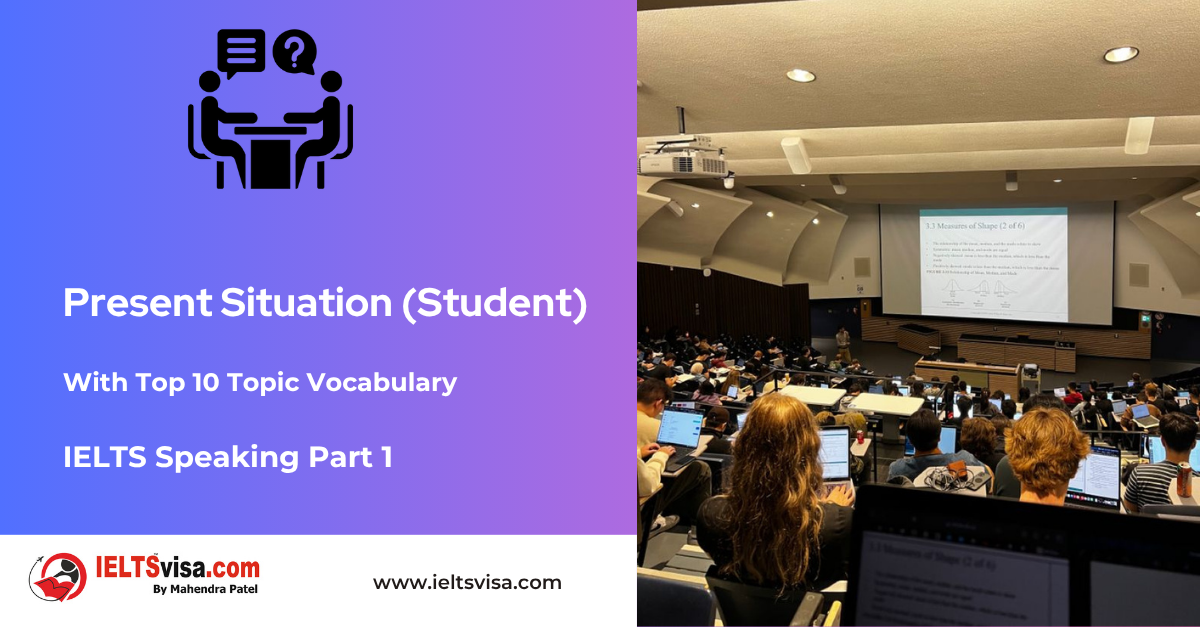IELTS Speaking Part 1 – Weather - India
IELTS Speaking Practice
IELTS Speaking Part 1 – Weather – India
Examiner: What’s the weather usually like in India?
Candidate: India’s climate is as diverse as its size and geographical features. The northern regions endure hot summers and cool to cold winters. In contrast, the southern regions are more tropical, with hot and humid weather year-round. The monsoon season, typically from June to September, brings heavy rainfall to most parts of the country, necessitating a range of coping strategies.
Examiner: What season are we in India right now?
Candidate: Right now, it’s [mention the current season in India, e.g., monsoon season/winter/summer]. This season is characterised by [mention typical weather conditions for the current season, e.g., heavy rainfall, cooler temperatures].
Examiner: Do you prefer hot or cold weather?
Candidate: Many people in India find the extreme heat of summer quite challenging. The monsoon season brings relief from the heat but can also be disruptive due to heavy rainfall. Personally, I prefer [mention your preference, e.g., the pleasant temperatures of winter or the occasional cool breeze during the monsoon].
Examiner: How do people in India cope with the hot weather?
Candidate: Staying cool during the hot summers is crucial! Many people rely on [mention ways to cope with the heat, e.g., staying hydrated with cooling drinks like lassi or buttermilk, wearing loose, cotton clothing, and spending time indoors in air-conditioned spaces].
Examiner: How do the monsoons affect life in India?
Candidate: The monsoons are vital for agriculture and replenishing water sources. However, heavy rainfall can also lead to floods and disruptions in transportation. People prepare for the monsoons by [mention ways people prepare, e.g., repairing roofs, stocking up on essential supplies].
Examiner: Are there any festivals or traditions associated with the different seasons in India?
Candidate: Absolutely! Festivals like Holi, the festival of colors, are not just about celebrating the change of seasons, but also about bringing communities together. Dussehra, celebrating the victory of good over evil, takes place in autumn. Many regions also have unique traditions associated with the arrival of the monsoons.
Examiner: Do you think climate change is affecting the weather patterns in India?
Candidate: There’s growing concern about the impact of climate change. Unpredictable rainfall patterns, more intense heatwaves, and extreme weather events are becoming more frequent. This is a severe concern for India’s agriculture and overall well-being.
Examiner: What can be done to address the challenges of extreme weather in India?
Candidate: Addressing the challenges of extreme weather in India requires a multi-pronged approach. It’s not just about investing in sustainable infrastructure, promoting water conservation techniques, and adopting climate-resilient agricultural practices. It’s also about raising public awareness and promoting individual actions to reduce our carbon footprint, which can all contribute to a positive impact.
Examiner: Do you think it’s essential to be aware of weather forecasts in India?
Candidate: Absolutely! Weather forecasts, especially during the monsoon season, play a crucial role in helping people prepare for potential disruptions and stay safe from extreme weather events. Following weather warnings and taking necessary precautions is not just important, it’s essential.
Examiner: How do you typically get your weather updates?
Candidate: There are many ways to stay informed! Many news channels and websites provide weather forecasts. Mobile apps dedicated to weather updates are also top-rated. Additionally, some traditional methods, like observing cloud formations, are still used in rural areas.
Examiner: What are some regional variations in weather patterns across India?
Candidate: India’s diverse geography leads to significant regional variations. For example, the Himalayan regions experience year-round snowfall. At the same time, coastal areas in the South have a more tropical climate with consistent temperatures. The Thar Desert in the west experiences extreme aridity, while the northeastern states receive heavy rainfall yearly.
Examiner: Do you think the weather in India is suitable for outdoor activities year-round?
Candidate: The answer depends on the specific activity and your personal heat tolerance. Winters, especially in the north, offer pleasant conditions for outdoor adventures. The monsoon season might limit some activities due to heavy rain, but it’s a good time for scenic hikes in lush green landscapes. Summers can be challenging, with some outdoor activities best enjoyed early mornings or evenings.
Examiner: How does the weather impact the way people dress in India?
Candidate: Well! The weather heavily influences clothing choices in India. Loose, light-coloured cotton clothing is preferred during scorching summers for maximum breathability. Monsoons necessitate raincoats and waterproof footwear. Winters in the North might require layers and warmer clothing, while the South maintains a lighter wardrobe with minimal variations.
Examiner: Are there any traditional Indian dishes or drinks meant explicitly for the hot summer months?
Candidate: Indian cuisine offers refreshing options to combat the heat. Lassi, a yoghurt-based drink with cooling properties, is a popular choice. Contrary to popular belief, spicy foods can help induce sweating and regulate body temperature. Fruits like mangoes and watermelons are also a delicious and hydrating way to beat the heat.
Examiner: How do you think future technological advancements might help us better predict and prepare for extreme weather events in India?
Candidate: Advancements in weather forecasting technology hold promise. More accurate and localised weather predictions can help people prepare for potential disruptions. Early warnings about floods or heatwaves can allow authorities to implement preventive measures and minimise damage. Investing in weather monitoring technology can be a valuable tool for mitigating the impact of extreme weather events.
Top 10 Topic Vocabulary for “Weather – India”
|
Vocabulary |
Type |
Meaning |
Synonyms |
Antonyms |
Word Family |
Example Sentences |
|
Monsoon |
Noun |
A seasonal wind that brings heavy rainfall to South Asia, particularly in India. |
Rainy season |
— |
— |
1. The monsoon season starts in June and continues until September. |
|
Humidity |
Noun |
The amount of moisture in the air. |
Moisture, dampness |
Dryness |
Humid (adj) |
1. High humidity levels can make the heat feel more intense. |
|
Heatwave |
Noun |
A prolonged period of scorching weather. |
Hot spell, heat surge |
Cold spell |
— |
1. The city experienced a severe heatwave last summer. |
|
Cyclone |
Noun |
A large-scale air mass that rotates around an intense centre of low atmospheric pressure. |
Hurricane, typhoon |
— |
— |
1. The cyclone caused widespread damage along the coast. |
|
Drought |
Noun |
A prolonged dry period with below-average precipitation. |
Dry spell, water shortage |
Flood |
— |
1. The region faced a severe drought affecting crops and water supply. |
|
Typhoon |
Noun |
A mature tropical cyclone that develops in the western Pacific Ocean. |
Cyclone, hurricane |
— |
— |
1. Typhoons often bring heavy rain and strong winds. |
|
Frost |
Noun |
Ice crystals form on surfaces when the temperature falls below the freezing point. |
Ice, freeze |
Thaw |
Frosty (adj) |
1. The early frost damaged the crops in the field. |
|
Thunderstorm |
Noun |
A storm with thunder, lightning, and often heavy rain. |
Storm, lightning storm |
— |
— |
1. The thunderstorm lasted through the night, bringing heavy rain and strong winds. |
|
Breeze |
Noun |
A gentle, mild wind. |
Gentle wind, zephyr |
Gale, storm |
Breezy (adj) |
1. A cool breeze made the hot afternoon more bearable. |
|
Drizzle |
Noun |
Light rain with tiny drops. |
Light rain, mist |
Downpour |
Drizzly (adj) |
1. The weather was overcast, with occasional drizzle throughout the day. |
|
Blizzard |
Noun |
A severe snowstorm with strong winds and low visibility. |
Snowstorm, whiteout |
— |
Blizzard (v), Blizzarding (n) |
1. The blizzard made travel impossible and caused power outages. |

Our Books
Master IELTS Speaking Part 1
IELTS Writing Task 1 Book
IELTS Writing Task 2 Book
Practice IELTS Other Modules
IELTS Listening
The IELTS Listening test assesses how well you can understand spoken English in various contexts. It lasts about 30 minutes and is divided into four sections with a total of 40 questions. The listening tasks become increasingly difficult as the test progresses.
IELTS Academic Reading
The IELTS Academic Reading section assesses your ability to understand and interpret a variety of texts in academic settings. It is designed to evaluate a range of reading skills, including skimming for gist, reading for main ideas, reading for detail, understanding inferences, and recognizing a writer's opinions and arguments.
IELTS Speaking
The IELTS Speaking test assesses your ability to communicate in English on everyday topics. It lasts 11-14 minutes and consists of three parts: introduction, cue card, and a discussion based on the cue card topic.
IELTS General Reading
IELTS General Reading tests your ability to understand and interpret various types of texts. Here are some key areas and types of content you can expect to encounter in the reading section, along with tips for effective preparation.
IELTS Academic Writing Task 1
In IELTS Academic Writing Task 1, you are presented with a visual representation of information, such as graphs, charts, tables, or diagrams, and you are required to summarize, compare, or explain the data in your own words.
IELTS General Writing Task 1
In IELTS General Writing Task 1, you are required to write a letter based on a given situation. The letter can be formal, semi-formal, or informal, depending on the prompt. Here’s a breakdown of the key components to include in your letter
IELTS Academic Writing Task 2
In IELTS Academic Writing Task 2, you are required to write an essay in response to a question or topic. Here’s a guide to help you understand the essential elements of this task
IELTS Exam Tips
To succeed in the IELTS exam, practice regularly, familiarize yourself with the test format, improve your vocabulary, develop time management skills, and take mock tests to build confidence.
Grammer for IELTS
Grammar is the foundation of effective communication in English. Understanding tense usage, subject-verb agreement, and sentence structure enhances clarity and coherence in writing and speaking.
Vocabulary for IELTS
Vocabulary plays a crucial role in the IELTS (International English Language Testing System) exam, especially in the Speaking and Writing sections. Here’s an overview of why vocabulary is important and how it impacts your performance
RECENT IELTS SAMPLES QUESTIONS AND ANSWERS
IELTS Speaking Part 1 – Favourite Sujbect – Physics
IELTS Speaking Part 1 - Favourite Sujbect - Physics Q: What is your favourite subject? A: My favourite subject...
IELTS Speaking Part 1 – Present Situation (Student)
IELTS Speaking Part 1 - Present Situation (Student) Q1: Are you a student or do you work?A: I’m a full-time...
IELTS Speaking Part 1 – Present Situation – Employee – as an International Student and Social Worker
IELTS Speaking Part 1 - Present Situation - Employee - as an International Student and Social Worker Q1: Are...
IELTS Speaking Part 1 – Persent Situation – Employee- as an Electric Engineer
IELTS Speaking Part 1 - Persent Situation - Employee- as an Electric Engineer Q1: What do you do for a...
IELTS Speaking Part 1 – Persent Situation – Employee – as an Software Engineer
IELTS Speaking Part 1 - Persent Situation - Employee - as an Software Engineer Q1: What do you do for a...
IELTS Speaking Part 1 – Persent Situation – Married
IELTS Speaking Part 1 - Persent Situation - Married Q1: Are you married?A: Yes, I am married. My spouse and I...













